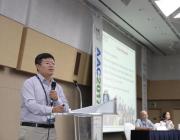摘要:
This study was part of the international field measurement Campaigns of Air Quality Research in Beijing and Surrounding Region 2006 (CAREBeijing-2006). We investigated a new particle formation event in a highly polluted air mass at a regional site south of the megacity Beijing and its impact on the abundance and properties of cloud condensation nuclei (CCN). During the 1-month observation, particle nucleation followed by significant particle growth on a regional scale was observed frequently (similar to 30%), and we chose 23 August 2006 as a representative case study. Secondary aerosol mass was produced continuously, with sulfate, ammonium, and organics as major components. The aerosol mass growth rate was on average 19 mu g m(-3) h(-1) during the late hours of the day. This growth rate was observed several times during the 1-month intensive measurements. The nucleation mode grew very quickly into the size range of CCN, and the CCN size distribution was dominated by the growing nucleation mode ( up to 80% of the total CCN number concentration) and not as usual by the accumulation mode. At water vapor supersaturations of 0.07-0.86%, the CCN number concentrations reached maximum values of 4000-19,000 cm(-3) only 6-14 h after the nucleation event. During particle formation and growth, the effective hygroscopicity parameter kappa increased from about 0.1-0.3 to 0.35-0.5 for particles with diameters of 40-90 nm, but it remained nearly constant at similar to 0.45 for particles with diameters of similar to 190 nm. This result is consistent with aerosol chemical composition data, showing a pronounced increase of sulfate.附注:
ISI Document Delivery No.: 439ZMTimes Cited: 111Cited Reference Count: 42Wiedensohler, A. Cheng, Y. F. Nowak, A. Wehner, B. Achtert, P. Berghof, M. Birmili, W. Wu, Z. J. Hu, M. Zhu, T. Takegawa, N. Kita, K. Kondo, Y. Lou, S. R. Hofzumahaus, A. Holland, F. Wahner, A. Gunthe, S. S. Rose, D. Su, H. Poeschl, U.Wahner, Andreas/J-4129-2012; ZHU, TONG/H-6501-2011; Hofzumahaus, Andreas/I-9420-2012; Kondo, Yutaka/D-1459-2012; Nowak, Andreas/B-6413-2014; Wiedensohler, Alfred/D-1223-2013; Gunthe, Sachin/E-4934-2016; Gunthe, Sachin/A-1970-2010; Cheng, Yafang/F-9362-2010; Holland, Frank/J-8812-2012; Rose, Diana/F-3142-2010; Poschl, Ulrich/A-6263-2010; Wehner, Birgit/C-2650-2014; Wu, Zhijun/A-7041-2012; Su, Hang/A-6226-2010Wahner, Andreas/0000-0001-8948-1928; ZHU, TONG/0000-0002-2752-7924; Hofzumahaus, Andreas/0000-0003-2876-0880; Gunthe, Sachin/0000-0002-7903-7783; Cheng, Yafang/0000-0003-4912-9879; Holland, Frank/0000-0002-2278-4761; Poschl, Ulrich/0000-0003-1412-3557; Su, Hang/0000-0003-4889-1669; Achtert, Peggy/0000-0003-0156-5276Beijing Council of Science and Technology [HB200504-6, HB200504-2]; Max Planck SocietyThis work as part of CAREBeijing-2006 (Campaigns of Air Quality Research in Beijing 2006) were mainly supported by Beijing Council of Science and Technology (HB200504-6 and HB200504-2). The authors wish to extend their gratitude to all participants for their good humor, enthusiasm, and openness to collaboration in the field measurements at the Yufa site and in the data evaluation. S. S. G., D. R., H. S., and U. P. thank M.O. Andreae and the Max Planck Society for support.115481Amer geophysical unionWashington